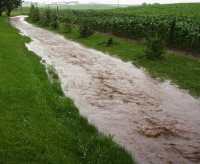
Every fall we try to haul soil back into the hills. The next picture shows an old washed out waterway and below it is a wet area almost every year. It was wet this spring.

The pictures below show a cross section of a corn row 1 foot deep. You can see the
corn roots for the row on the picture to the left.
Because of a wet spring and planting on wet soil along with a dry fall this 1/4 acre area
has shallow compaction. As you can see the Nightcrawlers are still actively boring holes
in this tight soil. This shallow layer of compaction will be fractured by winter freezing and
broken up by nightcrawlers boring holes in it.


The next pictures you see show the Nightcrawler's compost pile called a midden. This
is where the soil mixing occurs.
All these holes in the ground provide pathways for rain to infiltrate into the soil just
like a sponge. Tillage fills in these holes and compresses the soil together into smaller
particles which causes rain water to run off instead of soaking in. Just like compressing a
sponge.
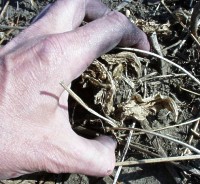


On the discussion of using tillage to remove deep compaction I've seen tightly compacted soil down as deep as 5 feet. Nightcrawlers will burrow down 8 feet and are the only way to restore the soil structure in these areas. Areas that have silted in are a perfect example. Below is a terrace that silted in over a period of 15 years of tillage. The soil is densely packed by years of silting and driving on it when wet.
Once nightcrawlers get established you'll notice rainwater won't stand on the surface but soak in at these areas.


Nightcrawlers avoid deeply compacted soils such as gateway areas that we load and
unload on every year. They will first populate the areas around it but eventually start
working into these areas.
Many of our earthworms in the US were introduced from Europe including the Nightcrawler (Lumbricus terrestris).
Most of our Native worms live in the virgin forests & prairies where the soil has been undisturbed.
Nightcrawler castings are pH neutral. The nightcrawler also uses this stubble to make its midden.
Nightcrawlers can tolerate a pH range from 4.5 to 8.2 but don't like rapid pH changes.
Worms on an average acre may eat, mix & move 7 tons of soil a year and produce 1/2 inch of new soil.
Below left is where there are no nightcrawlers and below right is a highly populated
nightcrawler area.
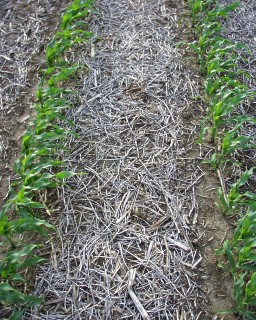
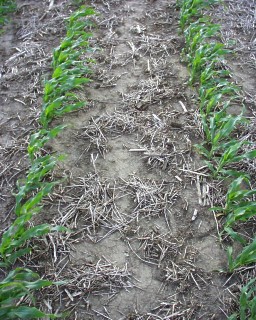
Below is an example of a field No-Tilled for almost 20 years (on the left) compared to continual tillage on the right.
The field on the right was deep subsoiled the previous fall. This field is chiseled every other year and subsoiled quite often.
As you can see some of the endrows have washed out and soil has buried the corn by the fence on the tilled side. Less than one inch of rain did this.
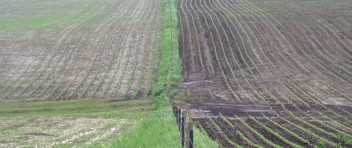
This doesn't prove that subsoiling didn't help because the tillage to prepare the soil presses out the air pockets and compresses the soil particles on the surface into smaller ones. The water has no place to go but run off the surface even though there are fracture slots underneath from the subsoiling.

Below is the water that ran off that field from above which is only about a 7 acre C
slope watershed area. We never use to have a waterway here but have to now to carry
the run-off.
My theory is that the tilled field has lost too much of the topsoil and more clay is
exposed now than years ago. Clay won't take in water as readily as good topsoil. I also
feel that compaction, both shallow and deep, is a problem with this tilled field.
